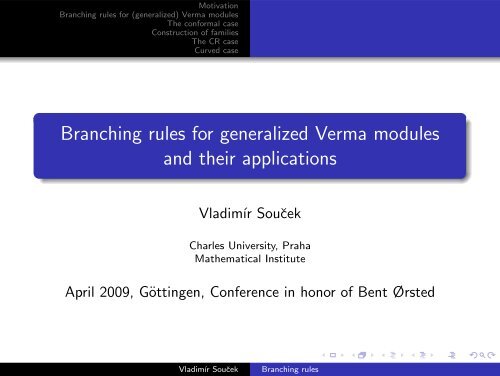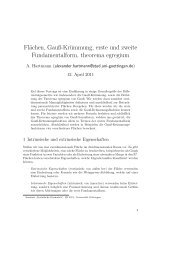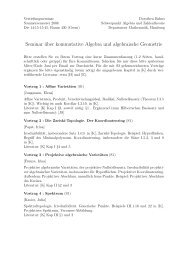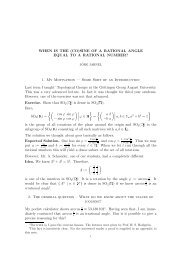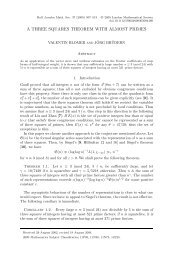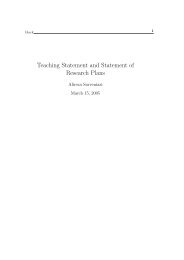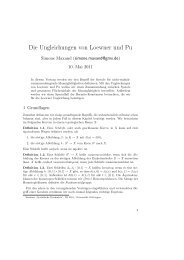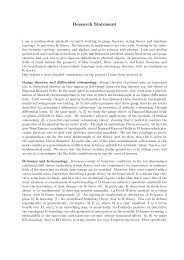Branching rules for generalized Verma modules and their applications
Branching rules for generalized Verma modules and their applications
Branching rules for generalized Verma modules and their applications
You also want an ePaper? Increase the reach of your titles
YUMPU automatically turns print PDFs into web optimized ePapers that Google loves.
Motivation<br />
<strong>Branching</strong> <strong>rules</strong> <strong>for</strong> (<strong>generalized</strong>) <strong>Verma</strong> <strong>modules</strong><br />
The con<strong>for</strong>mal case<br />
Construction of families<br />
The CR case<br />
Curved case<br />
<strong>Branching</strong> <strong>rules</strong> <strong>for</strong> <strong>generalized</strong> <strong>Verma</strong> <strong>modules</strong><br />
<strong>and</strong> <strong>their</strong> <strong>applications</strong><br />
Vladimír Souček<br />
Charles University, Praha<br />
Mathematical Institute<br />
April 2009, Göttingen, Conference in honor of Bent Ørsted<br />
Vladimír Souček<br />
<strong>Branching</strong> <strong>rules</strong>
Motivation<br />
<strong>Branching</strong> <strong>rules</strong> <strong>for</strong> (<strong>generalized</strong>) <strong>Verma</strong> <strong>modules</strong><br />
The con<strong>for</strong>mal case<br />
Construction of families<br />
The CR case<br />
Curved case<br />
Contents<br />
1 Motivation<br />
2 <strong>Branching</strong> <strong>rules</strong> <strong>for</strong> (<strong>generalized</strong>) <strong>Verma</strong> <strong>modules</strong><br />
3 The con<strong>for</strong>mal case<br />
4 Construction of families<br />
5 The CR case<br />
6 Curved case<br />
Vladimír Souček<br />
<strong>Branching</strong> <strong>rules</strong>
Motivation<br />
<strong>Branching</strong> <strong>rules</strong> <strong>for</strong> (<strong>generalized</strong>) <strong>Verma</strong> <strong>modules</strong><br />
The con<strong>for</strong>mal case<br />
Construction of families<br />
The CR case<br />
Curved case<br />
Contents<br />
1 Motivation<br />
2 <strong>Branching</strong> <strong>rules</strong> <strong>for</strong> (<strong>generalized</strong>) <strong>Verma</strong> <strong>modules</strong><br />
3 The con<strong>for</strong>mal case<br />
4 Construction of families<br />
5 The CR case<br />
6 Curved case<br />
Vladimír Souček<br />
<strong>Branching</strong> <strong>rules</strong>
Motivation<br />
<strong>Branching</strong> <strong>rules</strong> <strong>for</strong> (<strong>generalized</strong>) <strong>Verma</strong> <strong>modules</strong><br />
The con<strong>for</strong>mal case<br />
Construction of families<br />
The CR case<br />
Curved case<br />
Flat case, the classical correspondence<br />
interplay between differential geometry <strong>and</strong> representation<br />
theory<br />
Vladimír Souček<br />
<strong>Branching</strong> <strong>rules</strong>
Motivation<br />
<strong>Branching</strong> <strong>rules</strong> <strong>for</strong> (<strong>generalized</strong>) <strong>Verma</strong> <strong>modules</strong><br />
The con<strong>for</strong>mal case<br />
Construction of families<br />
The CR case<br />
Curved case<br />
Flat case, the classical correspondence<br />
interplay between differential geometry <strong>and</strong> representation<br />
theory<br />
1-1 map between the invariant differential operators <strong>and</strong><br />
homomorphisms of the corresponding (<strong>generalized</strong>) <strong>Verma</strong><br />
<strong>modules</strong>.<br />
Vladimír Souček<br />
<strong>Branching</strong> <strong>rules</strong>
Motivation<br />
<strong>Branching</strong> <strong>rules</strong> <strong>for</strong> (<strong>generalized</strong>) <strong>Verma</strong> <strong>modules</strong><br />
The con<strong>for</strong>mal case<br />
Construction of families<br />
The CR case<br />
Curved case<br />
Flat case, the classical correspondence<br />
interplay between differential geometry <strong>and</strong> representation<br />
theory<br />
1-1 map between the invariant differential operators <strong>and</strong><br />
homomorphisms of the corresponding (<strong>generalized</strong>) <strong>Verma</strong><br />
<strong>modules</strong>.<br />
G semisimple Lie group, P parabolic subgroup, X = G/P<br />
<strong>generalized</strong> flag manifold<br />
V, W two finite-dimensional irreducible P-<strong>modules</strong><br />
there is a bijective correspondence between intertwining<br />
differential operators D : C ∞ (G, V) P ↦→ C ∞ (G, W) P <strong>and</strong><br />
G-homomorphisms between (<strong>generalized</strong>) <strong>Verma</strong> <strong>modules</strong><br />
D : M(W ∗ ) ↦→ M(V ∗ ).<br />
Vladimír Souček<br />
<strong>Branching</strong> <strong>rules</strong>
Motivation<br />
<strong>Branching</strong> <strong>rules</strong> <strong>for</strong> (<strong>generalized</strong>) <strong>Verma</strong> <strong>modules</strong><br />
The con<strong>for</strong>mal case<br />
Construction of families<br />
The CR case<br />
Curved case<br />
Invariant operators between different dimensions<br />
con<strong>for</strong>mal geometry, (continuous) families D λ of invariant<br />
differential operators of a given order k between a manifold<br />
<strong>and</strong> its submanifold (of codimension one)<br />
Vladimír Souček<br />
<strong>Branching</strong> <strong>rules</strong>
Motivation<br />
<strong>Branching</strong> <strong>rules</strong> <strong>for</strong> (<strong>generalized</strong>) <strong>Verma</strong> <strong>modules</strong><br />
The con<strong>for</strong>mal case<br />
Construction of families<br />
The CR case<br />
Curved case<br />
Invariant operators between different dimensions<br />
con<strong>for</strong>mal geometry, (continuous) families D λ of invariant<br />
differential operators of a given order k between a manifold<br />
<strong>and</strong> its submanifold (of codimension one)<br />
A. Juhl: Families of con<strong>for</strong>mally covariant differential<br />
operators, Q-curvature <strong>and</strong> holography, Birkhäuser, Progress<br />
in Math., to appear in May 2009<br />
- motivation from Selberg zeta function <strong>and</strong> automorphic<br />
distributions<br />
- a curved version of those operators is related to the<br />
Q-curvature in con<strong>for</strong>mal geometry<br />
Vladimír Souček<br />
<strong>Branching</strong> <strong>rules</strong>
Motivation<br />
<strong>Branching</strong> <strong>rules</strong> <strong>for</strong> (<strong>generalized</strong>) <strong>Verma</strong> <strong>modules</strong><br />
The con<strong>for</strong>mal case<br />
Construction of families<br />
The CR case<br />
Curved case<br />
T. Branson, R. Gover: Con<strong>for</strong>mally invariant non-local<br />
operators, Pac. Jour. Math, 2001,<br />
- families D λ are used <strong>for</strong> a boundary value problem in a<br />
construction of con<strong>for</strong>mally invariant (non-local) operators<br />
Vladimír Souček<br />
<strong>Branching</strong> <strong>rules</strong>
Motivation<br />
<strong>Branching</strong> <strong>rules</strong> <strong>for</strong> (<strong>generalized</strong>) <strong>Verma</strong> <strong>modules</strong><br />
The con<strong>for</strong>mal case<br />
Construction of families<br />
The CR case<br />
Curved case<br />
T. Branson, R. Gover: Con<strong>for</strong>mally invariant non-local<br />
operators, Pac. Jour. Math, 2001,<br />
- families D λ are used <strong>for</strong> a boundary value problem in a<br />
construction of con<strong>for</strong>mally invariant (non-local) operators<br />
R. Gover: Con<strong>for</strong>mal Dirichlet-Neumann maps <strong>and</strong><br />
Poincaré-Einstein manifolds, SIGMA, 3, 2007,<br />
Vladimír Souček<br />
<strong>Branching</strong> <strong>rules</strong>
Motivation<br />
<strong>Branching</strong> <strong>rules</strong> <strong>for</strong> (<strong>generalized</strong>) <strong>Verma</strong> <strong>modules</strong><br />
The con<strong>for</strong>mal case<br />
Construction of families<br />
The CR case<br />
Curved case<br />
the Juhl family - flat case<br />
Invariant differential operators between irreducible bundles but<br />
in different dimensions(!)<br />
Vladimír Souček<br />
<strong>Branching</strong> <strong>rules</strong>
Motivation<br />
<strong>Branching</strong> <strong>rules</strong> <strong>for</strong> (<strong>generalized</strong>) <strong>Verma</strong> <strong>modules</strong><br />
The con<strong>for</strong>mal case<br />
Construction of families<br />
The CR case<br />
Curved case<br />
the Juhl family - flat case<br />
Invariant differential operators between irreducible bundles but<br />
in different dimensions(!)<br />
G (n) = SO 0 (n, 1) ⊂ G (n+1) = SO 0 (n + 1, 1)<br />
X = S n−1 = G (n) /P (n) ⊂ M = S n = G (n+1) /P (n+1)<br />
let k be a fixed positive integer;<br />
let R w be a character <strong>for</strong> P (n+1) , resp. <strong>for</strong> P (n) ,<br />
We want to construct a continuous family<br />
D w : C ∞ (G (n+1) , V −w+k ) P(n+1) ↦→ C ∞ (G (n) , V −w ) P(n)<br />
of differential operators commuting with the action of G (n) .<br />
Vladimír Souček<br />
<strong>Branching</strong> <strong>rules</strong>
Motivation<br />
<strong>Branching</strong> <strong>rules</strong> <strong>for</strong> (<strong>generalized</strong>) <strong>Verma</strong> <strong>modules</strong><br />
The con<strong>for</strong>mal case<br />
Construction of families<br />
The CR case<br />
Curved case<br />
the Juhl family - flat case<br />
Invariant differential operators between irreducible bundles but<br />
in different dimensions(!)<br />
G (n) = SO 0 (n, 1) ⊂ G (n+1) = SO 0 (n + 1, 1)<br />
X = S n−1 = G (n) /P (n) ⊂ M = S n = G (n+1) /P (n+1)<br />
let k be a fixed positive integer;<br />
let R w be a character <strong>for</strong> P (n+1) , resp. <strong>for</strong> P (n) ,<br />
We want to construct a continuous family<br />
D w : C ∞ (G (n+1) , V −w+k ) P(n+1) ↦→ C ∞ (G (n) , V −w ) P(n)<br />
of differential operators commuting with the action of G (n) .<br />
Dual <strong>for</strong>mulation: a family Φ w of g (n) -homomorphisms<br />
between (<strong>generalized</strong>) <strong>Verma</strong> <strong>modules</strong><br />
Φ w : M (n) (V w ) ↦→ M (n+1) (V w−k ).<br />
Vladimír Souček<br />
<strong>Branching</strong> <strong>rules</strong>
Motivation<br />
<strong>Branching</strong> <strong>rules</strong> <strong>for</strong> (<strong>generalized</strong>) <strong>Verma</strong> <strong>modules</strong><br />
The con<strong>for</strong>mal case<br />
Construction of families<br />
The CR case<br />
Curved case<br />
Continuous families of homomorphisms between different<br />
dimensions<br />
Suppose that there are branching <strong>rules</strong> <strong>for</strong> a continuous family<br />
of (<strong>generalized</strong>) <strong>Verma</strong> <strong>modules</strong> depending on a parametr w :<br />
M (n+1)<br />
w (V µ ) ≃ ⊕ αw ∈AM (n) (V αw )<br />
as G n -<strong>modules</strong>.<br />
Then in generic situation, all G n -homomorphisms of another<br />
(<strong>generalized</strong>) <strong>Verma</strong> module M (n) (W) to M w<br />
(n+1) (V µ ) are<br />
given by embeddings onto a component in the decomposition.<br />
Vladimír Souček<br />
<strong>Branching</strong> <strong>rules</strong>
Motivation<br />
<strong>Branching</strong> <strong>rules</strong> <strong>for</strong> (<strong>generalized</strong>) <strong>Verma</strong> <strong>modules</strong><br />
The con<strong>for</strong>mal case<br />
Construction of families<br />
The CR case<br />
Curved case<br />
Continuous families of homomorphisms between different<br />
dimensions<br />
Suppose that there are branching <strong>rules</strong> <strong>for</strong> a continuous family<br />
of (<strong>generalized</strong>) <strong>Verma</strong> <strong>modules</strong> depending on a parametr w :<br />
M (n+1)<br />
w (V µ ) ≃ ⊕ αw ∈AM (n) (V αw )<br />
as G n -<strong>modules</strong>.<br />
Then in generic situation, all G n -homomorphisms of another<br />
(<strong>generalized</strong>) <strong>Verma</strong> module M (n) (W) to M w<br />
(n+1) (V µ ) are<br />
given by embeddings onto a component in the decomposition.<br />
Hence to underst<strong>and</strong> constructions of continuous families, we<br />
have to underst<strong>and</strong> branching <strong>rules</strong> <strong>for</strong> <strong>Verma</strong> <strong>modules</strong>.<br />
Vladimír Souček<br />
<strong>Branching</strong> <strong>rules</strong>
Motivation<br />
<strong>Branching</strong> <strong>rules</strong> <strong>for</strong> (<strong>generalized</strong>) <strong>Verma</strong> <strong>modules</strong><br />
The con<strong>for</strong>mal case<br />
Construction of families<br />
The CR case<br />
Curved case<br />
Formulation of the problem<br />
Goal - <strong>for</strong>mulation <strong>and</strong> underst<strong>and</strong>ing of branching <strong>rules</strong> <strong>for</strong><br />
(<strong>generalized</strong>) <strong>Verma</strong> <strong>modules</strong> <strong>and</strong>, in particular, a description<br />
(explicit, if possible) of homomorphisms realizing the<br />
branching<br />
Vladimír Souček<br />
<strong>Branching</strong> <strong>rules</strong>
Motivation<br />
<strong>Branching</strong> <strong>rules</strong> <strong>for</strong> (<strong>generalized</strong>) <strong>Verma</strong> <strong>modules</strong><br />
The con<strong>for</strong>mal case<br />
Construction of families<br />
The CR case<br />
Curved case<br />
Formulation of the problem<br />
Goal - <strong>for</strong>mulation <strong>and</strong> underst<strong>and</strong>ing of branching <strong>rules</strong> <strong>for</strong><br />
(<strong>generalized</strong>) <strong>Verma</strong> <strong>modules</strong> <strong>and</strong>, in particular, a description<br />
(explicit, if possible) of homomorphisms realizing the<br />
branching<br />
An (explicit) description of corresponding invariant families of<br />
differential operators<br />
Vladimír Souček<br />
<strong>Branching</strong> <strong>rules</strong>
Motivation<br />
<strong>Branching</strong> <strong>rules</strong> <strong>for</strong> (<strong>generalized</strong>) <strong>Verma</strong> <strong>modules</strong><br />
The con<strong>for</strong>mal case<br />
Construction of families<br />
The CR case<br />
Curved case<br />
Formulation of the problem<br />
Goal - <strong>for</strong>mulation <strong>and</strong> underst<strong>and</strong>ing of branching <strong>rules</strong> <strong>for</strong><br />
(<strong>generalized</strong>) <strong>Verma</strong> <strong>modules</strong> <strong>and</strong>, in particular, a description<br />
(explicit, if possible) of homomorphisms realizing the<br />
branching<br />
An (explicit) description of corresponding invariant families of<br />
differential operators<br />
A study of curved analogues of these operators on curved<br />
versions of parabolic geometries<br />
Vladimír Souček<br />
<strong>Branching</strong> <strong>rules</strong>
Motivation<br />
<strong>Branching</strong> <strong>rules</strong> <strong>for</strong> (<strong>generalized</strong>) <strong>Verma</strong> <strong>modules</strong><br />
The con<strong>for</strong>mal case<br />
Construction of families<br />
The CR case<br />
Curved case<br />
Formulation of the problem<br />
Goal - <strong>for</strong>mulation <strong>and</strong> underst<strong>and</strong>ing of branching <strong>rules</strong> <strong>for</strong><br />
(<strong>generalized</strong>) <strong>Verma</strong> <strong>modules</strong> <strong>and</strong>, in particular, a description<br />
(explicit, if possible) of homomorphisms realizing the<br />
branching<br />
An (explicit) description of corresponding invariant families of<br />
differential operators<br />
A study of curved analogues of these operators on curved<br />
versions of parabolic geometries<br />
On going research project with B. Ørsted (Aarhus) <strong>and</strong> P.<br />
Somberg (Prague)<br />
Vladimír Souček<br />
<strong>Branching</strong> <strong>rules</strong>
Motivation<br />
<strong>Branching</strong> <strong>rules</strong> <strong>for</strong> (<strong>generalized</strong>) <strong>Verma</strong> <strong>modules</strong><br />
The con<strong>for</strong>mal case<br />
Construction of families<br />
The CR case<br />
Curved case<br />
Contents<br />
1 Motivation<br />
2 <strong>Branching</strong> <strong>rules</strong> <strong>for</strong> (<strong>generalized</strong>) <strong>Verma</strong> <strong>modules</strong><br />
3 The con<strong>for</strong>mal case<br />
4 Construction of families<br />
5 The CR case<br />
6 Curved case<br />
Vladimír Souček<br />
<strong>Branching</strong> <strong>rules</strong>
Motivation<br />
<strong>Branching</strong> <strong>rules</strong> <strong>for</strong> (<strong>generalized</strong>) <strong>Verma</strong> <strong>modules</strong><br />
The con<strong>for</strong>mal case<br />
Construction of families<br />
The CR case<br />
Curved case<br />
Generalized <strong>Verma</strong> <strong>modules</strong><br />
Let g be a complex simple Lie algebra, p its parabolic subgroup,<br />
g = p ⊕ n − , let g 0 ⊂ p be the Levi factor of p <strong>and</strong> h the Cartan<br />
subalgebra. Consider Λ ∈ h ∗ dominant <strong>and</strong> integral <strong>for</strong> p <strong>and</strong> let<br />
V Λ be the corresponding finite dimensional irreducible<br />
representation of p with highest weight Λ. Then the (<strong>generalized</strong>)<br />
<strong>Verma</strong> module M Λ is defined as<br />
M Λ := U(g) ⊗ U(p) V Λ .<br />
It is a universal highest weight module with weight Λ. As a vector<br />
space, it is isomorphic to U(n − ).<br />
Multiplicity of a weight space U(n − ) λ is given by the Kostant<br />
partition function.<br />
Vladimír Souček<br />
<strong>Branching</strong> <strong>rules</strong>
Motivation<br />
<strong>Branching</strong> <strong>rules</strong> <strong>for</strong> (<strong>generalized</strong>) <strong>Verma</strong> <strong>modules</strong><br />
The con<strong>for</strong>mal case<br />
Construction of families<br />
The CR case<br />
Curved case<br />
the case SL 3 ↦→ SL 2 , Borel case<br />
g = sl 3 , b upper triangular (Borel) g = b ⊕ n −<br />
g ′ = sl 2 embedded to the left upper corner<br />
roots of sl 3 : ±α, ±β, ±γ; γ = α + β,<br />
roots in n − : −α, −β, −γ,<br />
root elements Y α , Y β , Y γ <strong>for</strong> negative roots<br />
roots of sl 2 : are ±α<br />
a basis in the <strong>Verma</strong> module with a highest weight vector v :<br />
{Y j αY k γ Y l β | ≡ αj β k γ l , v ∈ M λ ; j, k, l ∈ N 0 }<br />
M 0 := . . . α 3 v α 2 v αv v<br />
M 1 := . . . α3 βv α 2 βv αβv βv<br />
. . . α 2 γv α γ v γv<br />
Vladimír Souček<br />
<strong>Branching</strong> <strong>rules</strong>
Motivation<br />
<strong>Branching</strong> <strong>rules</strong> <strong>for</strong> (<strong>generalized</strong>) <strong>Verma</strong> <strong>modules</strong><br />
The con<strong>for</strong>mal case<br />
Construction of families<br />
The CR case<br />
Curved case<br />
1<br />
1<br />
2 1<br />
2 1<br />
3 2 1<br />
3 2 1<br />
4 3 2 1<br />
4 3 2<br />
Y γ<br />
ւ<br />
Y β<br />
↓<br />
5 4 3 1 Yα<br />
տ<br />
5 4 2<br />
5 3 1<br />
4 2<br />
5 3 1<br />
Vladimír Souček 4 <strong>Branching</strong> 2 <strong>rules</strong>
Motivation<br />
<strong>Branching</strong> <strong>rules</strong> <strong>for</strong> (<strong>generalized</strong>) <strong>Verma</strong> <strong>modules</strong><br />
The con<strong>for</strong>mal case<br />
Construction of families<br />
The CR case<br />
Curved case<br />
1<br />
2 1<br />
2 1<br />
3 2 1<br />
3 2 1<br />
4 3 2 1<br />
4 3 2<br />
5 4 3 1<br />
5 4 2<br />
5 3 1<br />
4 2<br />
5 3 1<br />
4 2<br />
Vladimír Souček<br />
<strong>Branching</strong> <strong>rules</strong>
Motivation<br />
<strong>Branching</strong> <strong>rules</strong> <strong>for</strong> (<strong>generalized</strong>) <strong>Verma</strong> <strong>modules</strong><br />
The con<strong>for</strong>mal case<br />
Construction of families<br />
The CR case<br />
Curved case<br />
1<br />
2 1<br />
2 1<br />
3 2 1<br />
3 2 1<br />
4 3 2 1<br />
4 3 2<br />
5 4 3 1<br />
5 4 2<br />
5 3 1<br />
4 2<br />
5 3 1<br />
4 2<br />
Vladimír Souček<br />
<strong>Branching</strong> <strong>rules</strong>
Motivation<br />
<strong>Branching</strong> <strong>rules</strong> <strong>for</strong> (<strong>generalized</strong>) <strong>Verma</strong> <strong>modules</strong><br />
The con<strong>for</strong>mal case<br />
Construction of families<br />
The CR case<br />
Curved case<br />
Theorem<br />
Let λ = (λ 1 , λ 2 , λ 3 ) be a highest weight of the <strong>Verma</strong> module M (3)<br />
λ<br />
<strong>for</strong> l 3 . Then it decomposes (as l 2 -module) <strong>for</strong> a generic weight as<br />
M (3)<br />
λ<br />
= ∑<br />
M (2)<br />
(λ 1 −m,λ 2 −n)<br />
m,n∈N 0<br />
Indeed, α = (1, −1, 0), β = (0, 1, −1), γ = (1, 0, −1), hence<br />
λ − nβ − mγ = (λ 1 − m, λ 2 − n, ∗).<br />
Vladimír Souček<br />
<strong>Branching</strong> <strong>rules</strong>
Motivation<br />
<strong>Branching</strong> <strong>rules</strong> <strong>for</strong> (<strong>generalized</strong>) <strong>Verma</strong> <strong>modules</strong><br />
The con<strong>for</strong>mal case<br />
Construction of families<br />
The CR case<br />
Curved case<br />
A simple computation implies that there is a singular vector in<br />
each weight in boxes.<br />
Exceptional cases - individual <strong>Verma</strong> <strong>modules</strong> are included one in<br />
another<br />
When M λ is not irreducible <strong>for</strong> l 3 , we can make a quotient with the<br />
maximal podmodule - it is possible to deduce the usual branching<br />
<strong>rules</strong> <strong>for</strong> finite dimensional <strong>modules</strong><br />
Vladimír Souček<br />
<strong>Branching</strong> <strong>rules</strong>
Motivation<br />
<strong>Branching</strong> <strong>rules</strong> <strong>for</strong> (<strong>generalized</strong>) <strong>Verma</strong> <strong>modules</strong><br />
The con<strong>for</strong>mal case<br />
Construction of families<br />
The CR case<br />
Curved case<br />
the case SL 3 ↦→ SL 2 , parabolic case<br />
1<br />
2 1<br />
2 1<br />
2 2 1<br />
2 2 1<br />
2 2 2 1<br />
2 2 2<br />
2 2 2 1<br />
2 2 1<br />
2 1 0<br />
1 0<br />
1 0 0<br />
Vladimír Souček <strong>Branching</strong> <strong>rules</strong>
Motivation<br />
<strong>Branching</strong> <strong>rules</strong> <strong>for</strong> (<strong>generalized</strong>) <strong>Verma</strong> <strong>modules</strong><br />
The con<strong>for</strong>mal case<br />
Construction of families<br />
The CR case<br />
Curved case<br />
Theorem<br />
Let λ = (λ 1 |λ 2 , λ 3 ) be a p-dominant weight ane let the <strong>generalized</strong><br />
(3)<br />
<strong>Verma</strong> module M p λ<br />
<strong>for</strong> l 3 . Then it decomposes (as l 2 -module) <strong>for</strong><br />
a generic weight as<br />
(3)<br />
M p λ = ∑<br />
(2)<br />
M p (λ 1 −m,λ 2 −n)<br />
m,n∈N 0 ,λ 2 −n≥λ 3<br />
Vladimír Souček<br />
<strong>Branching</strong> <strong>rules</strong>
Motivation<br />
<strong>Branching</strong> <strong>rules</strong> <strong>for</strong> (<strong>generalized</strong>) <strong>Verma</strong> <strong>modules</strong><br />
The con<strong>for</strong>mal case<br />
Construction of families<br />
The CR case<br />
Curved case<br />
General result<br />
A careful study of multiplicity-one theorems <strong>and</strong> branching<br />
<strong>rules</strong> in general situation (in particular <strong>for</strong> unitary highest<br />
weight <strong>modules</strong>) can be found in<br />
T. Kobayashi: Multiplicity-free theorems of the restrictions of<br />
unitary highest weight <strong>modules</strong> with respect to reductive<br />
symmetric pairs, Progress in Math., Birkhäuser, 2006<br />
T. Kobayashi: Discrete decomposability of the restriction of<br />
A q (λ) with respect to reductive subgroup, Invent. Math. III,<br />
131, 1997, 229-256<br />
Vladimír Souček<br />
<strong>Branching</strong> <strong>rules</strong>
Motivation<br />
<strong>Branching</strong> <strong>rules</strong> <strong>for</strong> (<strong>generalized</strong>) <strong>Verma</strong> <strong>modules</strong><br />
The con<strong>for</strong>mal case<br />
Construction of families<br />
The CR case<br />
Curved case<br />
Contents<br />
1 Motivation<br />
2 <strong>Branching</strong> <strong>rules</strong> <strong>for</strong> (<strong>generalized</strong>) <strong>Verma</strong> <strong>modules</strong><br />
3 The con<strong>for</strong>mal case<br />
4 Construction of families<br />
5 The CR case<br />
6 Curved case<br />
Vladimír Souček<br />
<strong>Branching</strong> <strong>rules</strong>
Motivation<br />
<strong>Branching</strong> <strong>rules</strong> <strong>for</strong> (<strong>generalized</strong>) <strong>Verma</strong> <strong>modules</strong><br />
The con<strong>for</strong>mal case<br />
Construction of families<br />
The CR case<br />
Curved case<br />
The con<strong>for</strong>mal case<br />
The sphere S n is a homogeneous space G/P, with<br />
G = G (n) = SO(n + 1, 1) <strong>and</strong> it contains the sphere S n−1 given as<br />
a homogeneous space G/P with G = G (n−1) .<br />
Let g (n) = so(n + 1, 1), g (n−1) = so(n, 1) with the st<strong>and</strong>ard<br />
embedding g (n−1) ⊂ g (n)<br />
Let g (n) = gp (n) ⊕ n (n)<br />
−<br />
<strong>and</strong> the same in one dimension below.<br />
Let {Y 1 , . . .,Y n } a basis of n (n)<br />
− such that {Y 1, . . .,Y n−1 } is a<br />
basis of n (n−1)<br />
− .<br />
Irreducible p (n) -<strong>modules</strong> are labeled by weights Λ = (λ 1 |λ 2 , . . .,λ k )<br />
dominant integral <strong>for</strong> p.<br />
Let us split Λ as λ = (w, λ) with w ∈ R being the con<strong>for</strong>mal<br />
weight <strong>and</strong> λ being a dominant integral weight <strong>for</strong> so(n).<br />
Similarly <strong>for</strong> Λ ′ = (w ′ , λ ′ ) <strong>for</strong> dimension n − 1 instead of n.<br />
Vladimír Souček<br />
<strong>Branching</strong> <strong>rules</strong>
Motivation<br />
<strong>Branching</strong> <strong>rules</strong> <strong>for</strong> (<strong>generalized</strong>) <strong>Verma</strong> <strong>modules</strong><br />
The con<strong>for</strong>mal case<br />
Construction of families<br />
The CR case<br />
Curved case<br />
<strong>Branching</strong> <strong>rules</strong> in con<strong>for</strong>mal case<br />
Theorem<br />
(T. Kobayashi) Let V w,λ be an irreducible p (n) -module <strong>and</strong> M (n)<br />
w,λ<br />
the corresponding <strong>generalized</strong> <strong>Verma</strong> module.<br />
Then we have in generic situation (i.e. up to a discrete set of w ′ s)<br />
the branching <strong>rules</strong><br />
M (n)<br />
w,λ ≃ ⊕ k∈Z ≥0<br />
⊕ λ ′ րλ M (n−1)<br />
w−k,λ ′ ,<br />
where λ ′ ր λ means that V<br />
λ ′ appears in the branching <strong>rules</strong> <strong>for</strong> V λ.<br />
In particular<br />
M (n)<br />
w,0 ≃ ⊕ k∈Z ≥0<br />
M (n−1)<br />
w−k,0 .<br />
Vladimír Souček<br />
<strong>Branching</strong> <strong>rules</strong>
Motivation<br />
<strong>Branching</strong> <strong>rules</strong> <strong>for</strong> (<strong>generalized</strong>) <strong>Verma</strong> <strong>modules</strong><br />
The con<strong>for</strong>mal case<br />
Construction of families<br />
The CR case<br />
Curved case<br />
Generic case<br />
Let v ∈ M (n+1) (λ) be the highest weight vector Then (Y n ) j v are<br />
not singular vectors <strong>for</strong> j > 1<br />
Denote ∆ = ∑ n−1<br />
1<br />
(Y j ) 2<br />
. . . ∆ 2 v . . . ∆v . . . v<br />
. . . ∆ 2 vY n v . . . ∆vY n v . . . Y n v<br />
. . . ∆ 2 v(Y n ) 2 v . . . d ∆ v(Y n ) 2 v . . . (Y n ) 2 v<br />
. . . ∆ 2 v(Y n ) 3 v . . . d∆v(Y n ) 3 v . . . (Y n ) 3 v<br />
. . . ∆ 2 v(Y n ) 4 v . . . d∆v(Y n ) 4 v . . . (Y n ) 4 v<br />
Vladimír Souček<br />
<strong>Branching</strong> <strong>rules</strong>
Motivation<br />
<strong>Branching</strong> <strong>rules</strong> <strong>for</strong> (<strong>generalized</strong>) <strong>Verma</strong> <strong>modules</strong><br />
The con<strong>for</strong>mal case<br />
Construction of families<br />
The CR case<br />
Curved case<br />
The order 4<br />
the singular vector u <strong>for</strong> the embedding in degree 4 has a <strong>for</strong>m<br />
u = 1 3 (2λ+n−7)(2λ+n−5)Y 4 n v −2(2λ+n−5)∆Y 2 n v +∆ 2 v,<br />
where ∆ = ∑ n−1<br />
1<br />
(Y j ) 2 <strong>and</strong> v is the highest weight vector in<br />
the ’big’ <strong>Verma</strong> module.<br />
Vladimír Souček<br />
<strong>Branching</strong> <strong>rules</strong>
Motivation<br />
<strong>Branching</strong> <strong>rules</strong> <strong>for</strong> (<strong>generalized</strong>) <strong>Verma</strong> <strong>modules</strong><br />
The con<strong>for</strong>mal case<br />
Construction of families<br />
The CR case<br />
Curved case<br />
The order 4<br />
the singular vector u <strong>for</strong> the embedding in degree 4 has a <strong>for</strong>m<br />
u = 1 3 (2λ+n−7)(2λ+n−5)Y 4 n v −2(2λ+n−5)∆Y 2 n v +∆ 2 v,<br />
where ∆ = ∑ n−1<br />
1<br />
(Y j ) 2 <strong>and</strong> v is the highest weight vector in<br />
the ’big’ <strong>Verma</strong> module.<br />
<strong>for</strong> 2λ + n − 7 = 0 or 2λ + n − 5 = 0, something special<br />
happens<br />
Vladimír Souček<br />
<strong>Branching</strong> <strong>rules</strong>
Motivation<br />
<strong>Branching</strong> <strong>rules</strong> <strong>for</strong> (<strong>generalized</strong>) <strong>Verma</strong> <strong>modules</strong><br />
The con<strong>for</strong>mal case<br />
Construction of families<br />
The CR case<br />
Curved case<br />
Contents<br />
1 Motivation<br />
2 <strong>Branching</strong> <strong>rules</strong> <strong>for</strong> (<strong>generalized</strong>) <strong>Verma</strong> <strong>modules</strong><br />
3 The con<strong>for</strong>mal case<br />
4 Construction of families<br />
5 The CR case<br />
6 Curved case<br />
Vladimír Souček<br />
<strong>Branching</strong> <strong>rules</strong>
Motivation<br />
<strong>Branching</strong> <strong>rules</strong> <strong>for</strong> (<strong>generalized</strong>) <strong>Verma</strong> <strong>modules</strong><br />
The con<strong>for</strong>mal case<br />
Construction of families<br />
The CR case<br />
Curved case<br />
Splitting operators<br />
Splitting operators are particular types of invariant differential<br />
operators between irreducible <strong>and</strong> non-decomposable P-<strong>modules</strong>.<br />
Let V = V λ be an irreducible G-module with the highest weight<br />
λ = (λ 1 , λ 2 , . . .,λ k ). It is a non-decomposable P-module <strong>and</strong> it<br />
has a filtration by P-<strong>modules</strong>. The smallest element in the<br />
filtration W is an irreducible P-module. The same is true <strong>for</strong> the<br />
factor module W ′ of V by the biggest nontrivial P-submodule.<br />
So we have an invariant projection π of V onto W <strong>and</strong> an invariant<br />
embedding ι of W ′ into V. Let V, W <strong>and</strong> W ′ be the associated<br />
homogeneous bundles on G/P.<br />
Typical splitting operators:<br />
D λ : Γ(W) → Γ(V λ ), π ◦ D λ = α id, α ≠ 0,<br />
E λ : Γ(V λ ) → Γ(W ′ ), E λ ◦ ι = α id, α ≠ 0.<br />
We can twist V by a one dimensional module R[w].<br />
Vladimír Souček<br />
<strong>Branching</strong> <strong>rules</strong>
Motivation<br />
<strong>Branching</strong> <strong>rules</strong> <strong>for</strong> (<strong>generalized</strong>) <strong>Verma</strong> <strong>modules</strong><br />
The con<strong>for</strong>mal case<br />
Construction of families<br />
The CR case<br />
Curved case<br />
Example - st<strong>and</strong>ard tractor bundle.<br />
Consider defining g-module with highest weight Λ 0 = (1, 0, . . .,0).<br />
It splits under reduction to g 0 into three components with highest<br />
weights (1|0, . . .,0) ⊕ (0|1, 0, . . .,0) ⊕ (−1|0, . . .,0).<br />
Denote<br />
E A .. sections of (1, 0, . . .,0)<br />
E[1] .. sections of (1|0, . . .,0)<br />
E a [1] .. sections of (0|1, 0, . . .,0)<br />
E[−1] .. sections of (−1|0, . . .,0)<br />
Then E A [w] ≃ E[w + 1] ⊕ E a [w + 1] ⊕ E[w − 1].<br />
E[w + 1] is the irreducible quotion, E[−1] is irreducible subbundle.<br />
Vladimír Souček<br />
<strong>Branching</strong> <strong>rules</strong>
Motivation<br />
<strong>Branching</strong> <strong>rules</strong> <strong>for</strong> (<strong>generalized</strong>) <strong>Verma</strong> <strong>modules</strong><br />
The con<strong>for</strong>mal case<br />
Construction of families<br />
The CR case<br />
Curved case<br />
St<strong>and</strong>ard splitting operator<br />
D A : E[w + 1] ↦→ E A [w]<br />
⎛<br />
⎞<br />
w(n + 2w − 2)σ<br />
Dσ = ⎝(n + 2w − 2)∇ a σ⎠<br />
−∆σ<br />
E A : E A [w] ↦→ E[w − 1]<br />
⎛ ⎞<br />
σ<br />
E ⎝µ a<br />
⎠ = (w + 2n − 2)(w + n)ρ + (w + 2n − 2)∇ a µ a − ∆σ<br />
ρ<br />
Vladimír Souček<br />
<strong>Branching</strong> <strong>rules</strong>
Motivation<br />
<strong>Branching</strong> <strong>rules</strong> <strong>for</strong> (<strong>generalized</strong>) <strong>Verma</strong> <strong>modules</strong><br />
The con<strong>for</strong>mal case<br />
Construction of families<br />
The CR case<br />
Curved case<br />
The second order family<br />
See Let Π A A<br />
denote the projection (induced by finite-dimensional<br />
′<br />
branching <strong>rules</strong> from g (n+1) to g (n) ) twisted by identity on R[w].<br />
Let E A′ is the splitting operator <strong>for</strong> g (n) . Then the composition<br />
D 2 (w) := E A′ ◦ Π A A<br />
◦ D ′ A maps E[1] to cE ′ [−1] <strong>and</strong> is con<strong>for</strong>mally<br />
invariant.<br />
Explicitely<br />
D 2 (w)(σ) = (n + w − 3)[(n + 2w − 2)∆ ′ σ + (n + 2w − 3)∆σ]<br />
Vladimír Souček<br />
<strong>Branching</strong> <strong>rules</strong>
Motivation<br />
<strong>Branching</strong> <strong>rules</strong> <strong>for</strong> (<strong>generalized</strong>) <strong>Verma</strong> <strong>modules</strong><br />
The con<strong>for</strong>mal case<br />
Construction of families<br />
The CR case<br />
Curved case<br />
General strategy<br />
We want to construct an operator corresponding to a<br />
particular piece of the branching <strong>rules</strong>: M (n−1)<br />
w−2k,λ<br />
embedded<br />
′<br />
into M (n)<br />
w,λ<br />
Vladimír Souček<br />
<strong>Branching</strong> <strong>rules</strong>
Motivation<br />
<strong>Branching</strong> <strong>rules</strong> <strong>for</strong> (<strong>generalized</strong>) <strong>Verma</strong> <strong>modules</strong><br />
The con<strong>for</strong>mal case<br />
Construction of families<br />
The CR case<br />
Curved case<br />
General strategy<br />
We want to construct an operator corresponding to a<br />
particular piece of the branching <strong>rules</strong>: M (n−1)<br />
w−2k,λ<br />
embedded<br />
′<br />
into M (n)<br />
w,λ<br />
Find a splitting operator mapping sections E w,λ of bundle<br />
associated V w,λ to a tractor bundle twisted by a density<br />
Vladimír Souček<br />
<strong>Branching</strong> <strong>rules</strong>
Motivation<br />
<strong>Branching</strong> <strong>rules</strong> <strong>for</strong> (<strong>generalized</strong>) <strong>Verma</strong> <strong>modules</strong><br />
The con<strong>for</strong>mal case<br />
Construction of families<br />
The CR case<br />
Curved case<br />
General strategy<br />
We want to construct an operator corresponding to a<br />
particular piece of the branching <strong>rules</strong>: M (n−1)<br />
w−2k,λ<br />
embedded<br />
′<br />
into M (n)<br />
w,λ<br />
Find a splitting operator mapping sections E w,λ of bundle<br />
associated V w,λ to a tractor bundle twisted by a density<br />
Apply a suitably chosen projection coming from branching<br />
<strong>rules</strong> <strong>for</strong> the pair (g (n+1) , g (n) ) (twisted by a density<br />
representation).<br />
Vladimír Souček<br />
<strong>Branching</strong> <strong>rules</strong>
Motivation<br />
<strong>Branching</strong> <strong>rules</strong> <strong>for</strong> (<strong>generalized</strong>) <strong>Verma</strong> <strong>modules</strong><br />
The con<strong>for</strong>mal case<br />
Construction of families<br />
The CR case<br />
Curved case<br />
General strategy<br />
We want to construct an operator corresponding to a<br />
particular piece of the branching <strong>rules</strong>: M (n−1)<br />
w−2k,λ<br />
embedded<br />
′<br />
into M (n)<br />
w,λ<br />
Find a splitting operator mapping sections E w,λ of bundle<br />
associated V w,λ to a tractor bundle twisted by a density<br />
Apply a suitably chosen projection coming from branching<br />
<strong>rules</strong> <strong>for</strong> the pair (g (n+1) , g (n) ) (twisted by a density<br />
representation).<br />
All should be arranged in such a way that there is a<br />
differential splitting back to E w−2k,λ ′<br />
Vladimír Souček<br />
<strong>Branching</strong> <strong>rules</strong>
Motivation<br />
<strong>Branching</strong> <strong>rules</strong> <strong>for</strong> (<strong>generalized</strong>) <strong>Verma</strong> <strong>modules</strong><br />
The con<strong>for</strong>mal case<br />
Construction of families<br />
The CR case<br />
Curved case<br />
Contents<br />
1 Motivation<br />
2 <strong>Branching</strong> <strong>rules</strong> <strong>for</strong> (<strong>generalized</strong>) <strong>Verma</strong> <strong>modules</strong><br />
3 The con<strong>for</strong>mal case<br />
4 Construction of families<br />
5 The CR case<br />
6 Curved case<br />
Vladimír Souček<br />
<strong>Branching</strong> <strong>rules</strong>
Motivation<br />
<strong>Branching</strong> <strong>rules</strong> <strong>for</strong> (<strong>generalized</strong>) <strong>Verma</strong> <strong>modules</strong><br />
The con<strong>for</strong>mal case<br />
Construction of families<br />
The CR case<br />
Curved case<br />
The CR case<br />
The sphere S 2n+1 ⊂ C n is a homogeneous space G/P, with<br />
G = SU(n + 1, 1).<br />
g (n+1) = su(n + 1, 1), g (n) = su(n, 1) with the st<strong>and</strong>ard embedding<br />
g (n) ⊂ g (n+1)<br />
consider the corresponding parabolic subalgebras gp (n+1) <strong>and</strong> gp (n)<br />
nilpotent parts n (n+1)<br />
−<br />
<strong>and</strong> n (n)<br />
−<br />
have dimensions 2n + 1, resp.<br />
2n − 1 with a suitable bases {X 1 , . . .,X n , Y 1 , . . .,Y n , X }, resp.<br />
{X 1 , . . .,X n−1 , Y 1 , . . .,Y n−1 , X },<br />
Vladimír Souček<br />
<strong>Branching</strong> <strong>rules</strong>
Motivation<br />
<strong>Branching</strong> <strong>rules</strong> <strong>for</strong> (<strong>generalized</strong>) <strong>Verma</strong> <strong>modules</strong><br />
The con<strong>for</strong>mal case<br />
Construction of families<br />
The CR case<br />
Curved case<br />
Theorem<br />
(B.Ørsted, P. Somberg, VS) Let M (n+1) (λ, λ ′ ) be the <strong>generalized</strong><br />
<strong>Verma</strong> module induced by a character of g (n+1) , similarly <strong>for</strong><br />
M (n) (λ, λ ′ ).<br />
Then <strong>for</strong> every N ∈ N there is a family of g (n) -homomorphisms<br />
D : M (n) (λ − N, λ ′ ) ↦→ M (n+1) (λ, λ ′ ), λ, λ ′ ∈ C.<br />
Vladimír Souček<br />
<strong>Branching</strong> <strong>rules</strong>
Motivation<br />
<strong>Branching</strong> <strong>rules</strong> <strong>for</strong> (<strong>generalized</strong>) <strong>Verma</strong> <strong>modules</strong><br />
The con<strong>for</strong>mal case<br />
Construction of families<br />
The CR case<br />
Curved case<br />
The singular vector w <strong>for</strong> D 4 has a <strong>for</strong>m<br />
(λ+n−1)(λ+n−2)(X 2 n +Y 2 n ) 2 −2(λ+n−2)(X 2 n +Y 2 n )(∆ CR −2λ ′ X)<br />
+∆ 2 CR + 4λ′ ∆ CR X + 4(λ ′2 + λ + n − 1)X 2 ,<br />
where ∆ = ∑ n−1<br />
1<br />
(Y j ) 2 .<br />
Vladimír Souček<br />
<strong>Branching</strong> <strong>rules</strong>
Motivation<br />
<strong>Branching</strong> <strong>rules</strong> <strong>for</strong> (<strong>generalized</strong>) <strong>Verma</strong> <strong>modules</strong><br />
The con<strong>for</strong>mal case<br />
Construction of families<br />
The CR case<br />
Curved case<br />
The singular vector w <strong>for</strong> D 4 has a <strong>for</strong>m<br />
(λ+n−1)(λ+n−2)(X 2 n +Y 2 n ) 2 −2(λ+n−2)(X 2 n +Y 2 n )(∆ CR −2λ ′ X)<br />
+∆ 2 CR + 4λ′ ∆ CR X + 4(λ ′2 + λ + n − 1)X 2 ,<br />
where ∆ = ∑ n−1<br />
1<br />
(Y j ) 2 .<br />
<strong>for</strong> λ + n − 1 = 0 or λ + n − 2 = 0, something special happens<br />
Vladimír Souček<br />
<strong>Branching</strong> <strong>rules</strong>
Motivation<br />
<strong>Branching</strong> <strong>rules</strong> <strong>for</strong> (<strong>generalized</strong>) <strong>Verma</strong> <strong>modules</strong><br />
The con<strong>for</strong>mal case<br />
Construction of families<br />
The CR case<br />
Curved case<br />
The singular vector w <strong>for</strong> D 4 has a <strong>for</strong>m<br />
(λ+n−1)(λ+n−2)(X 2 n +Y 2 n ) 2 −2(λ+n−2)(X 2 n +Y 2 n )(∆ CR −2λ ′ X)<br />
+∆ 2 CR + 4λ′ ∆ CR X + 4(λ ′2 + λ + n − 1)X 2 ,<br />
where ∆ = ∑ n−1<br />
1<br />
(Y j ) 2 .<br />
<strong>for</strong> λ + n − 1 = 0 or λ + n − 2 = 0, something special happens<br />
Out of these special cases, the corresponding singular vectors<br />
generate the <strong>Verma</strong> <strong>modules</strong>, <strong>their</strong> sum is direct.<br />
Vladimír Souček<br />
<strong>Branching</strong> <strong>rules</strong>
Motivation<br />
<strong>Branching</strong> <strong>rules</strong> <strong>for</strong> (<strong>generalized</strong>) <strong>Verma</strong> <strong>modules</strong><br />
The con<strong>for</strong>mal case<br />
Construction of families<br />
The CR case<br />
Curved case<br />
Contents<br />
1 Motivation<br />
2 <strong>Branching</strong> <strong>rules</strong> <strong>for</strong> (<strong>generalized</strong>) <strong>Verma</strong> <strong>modules</strong><br />
3 The con<strong>for</strong>mal case<br />
4 Construction of families<br />
5 The CR case<br />
6 Curved case<br />
Vladimír Souček<br />
<strong>Branching</strong> <strong>rules</strong>
Motivation<br />
<strong>Branching</strong> <strong>rules</strong> <strong>for</strong> (<strong>generalized</strong>) <strong>Verma</strong> <strong>modules</strong><br />
The con<strong>for</strong>mal case<br />
Construction of families<br />
The CR case<br />
Curved case<br />
Curved case<br />
Manifolds with a given parabolic structure<br />
(G, ω), where G is P-principal bundle over M <strong>and</strong> ω is a<br />
Cartan connection on G<br />
invariant differential operators on homogeneous models have,<br />
as a rule, curved analogues<br />
Vladimír Souček<br />
<strong>Branching</strong> <strong>rules</strong>
Motivation<br />
<strong>Branching</strong> <strong>rules</strong> <strong>for</strong> (<strong>generalized</strong>) <strong>Verma</strong> <strong>modules</strong><br />
The con<strong>for</strong>mal case<br />
Construction of families<br />
The CR case<br />
Curved case<br />
Curved case<br />
Manifolds with a given parabolic structure<br />
(G, ω), where G is P-principal bundle over M <strong>and</strong> ω is a<br />
Cartan connection on G<br />
invariant differential operators on homogeneous models have,<br />
as a rule, curved analogues<br />
Example Con<strong>for</strong>mal case.<br />
manifold (M, [g]) with con<strong>for</strong>mal structure ≃<br />
fiber bundle G 0 → M with the structure group G 0 = CO(n)<br />
(resp. G 0 = CSpin(n)) prolongation to (G, ω)<br />
construction of (families of) natural differential operators<br />
acting between bundles associated to G 0 -nodules, resp.<br />
P-<strong>modules</strong><br />
Vladimír Souček<br />
<strong>Branching</strong> <strong>rules</strong>
Motivation<br />
<strong>Branching</strong> <strong>rules</strong> <strong>for</strong> (<strong>generalized</strong>) <strong>Verma</strong> <strong>modules</strong><br />
The con<strong>for</strong>mal case<br />
Construction of families<br />
The CR case<br />
Curved case<br />
Curved case<br />
Manifolds with a given parabolic structure<br />
(G, ω), where G is P-principal bundle over M <strong>and</strong> ω is a<br />
Cartan connection on G<br />
invariant differential operators on homogeneous models have,<br />
as a rule, curved analogues<br />
Example Con<strong>for</strong>mal case.<br />
manifold (M, [g]) with con<strong>for</strong>mal structure ≃<br />
fiber bundle G 0 → M with the structure group G 0 = CO(n)<br />
(resp. G 0 = CSpin(n)) prolongation to (G, ω)<br />
construction of (families of) natural differential operators<br />
acting between bundles associated to G 0 -nodules, resp.<br />
P-<strong>modules</strong><br />
Problem: To construct curved analogues of the flat families of<br />
invariant differential operators discussed above.<br />
Vladimír Souček<br />
<strong>Branching</strong> <strong>rules</strong>


